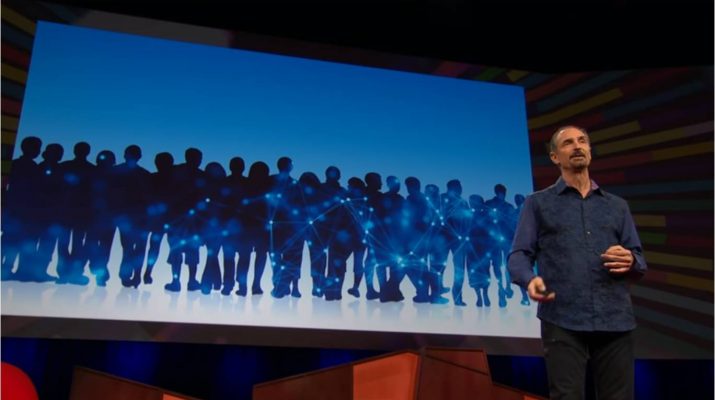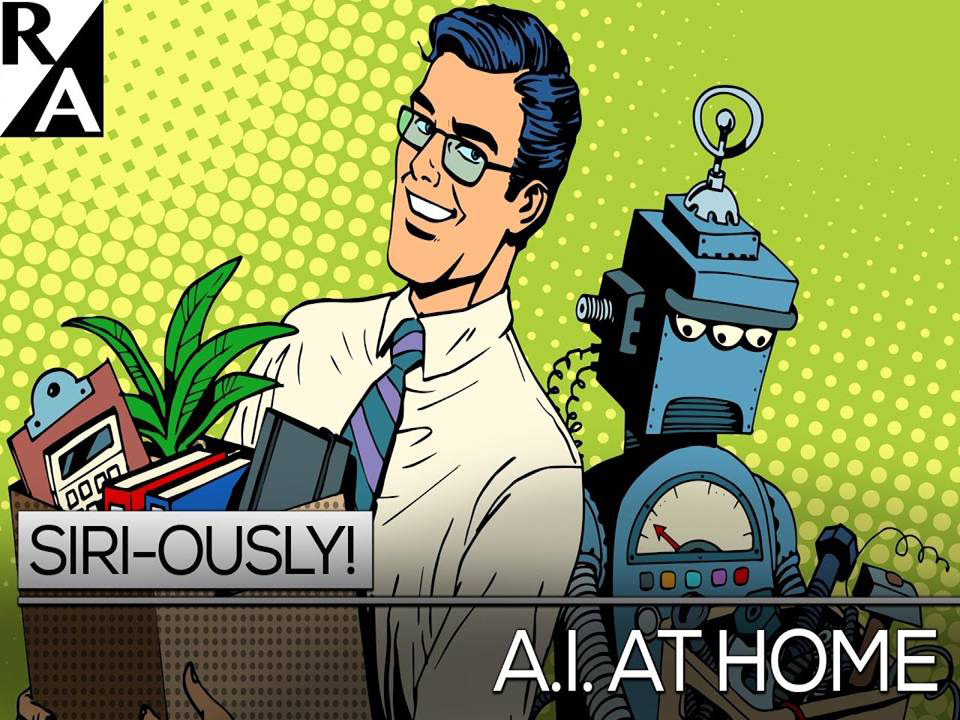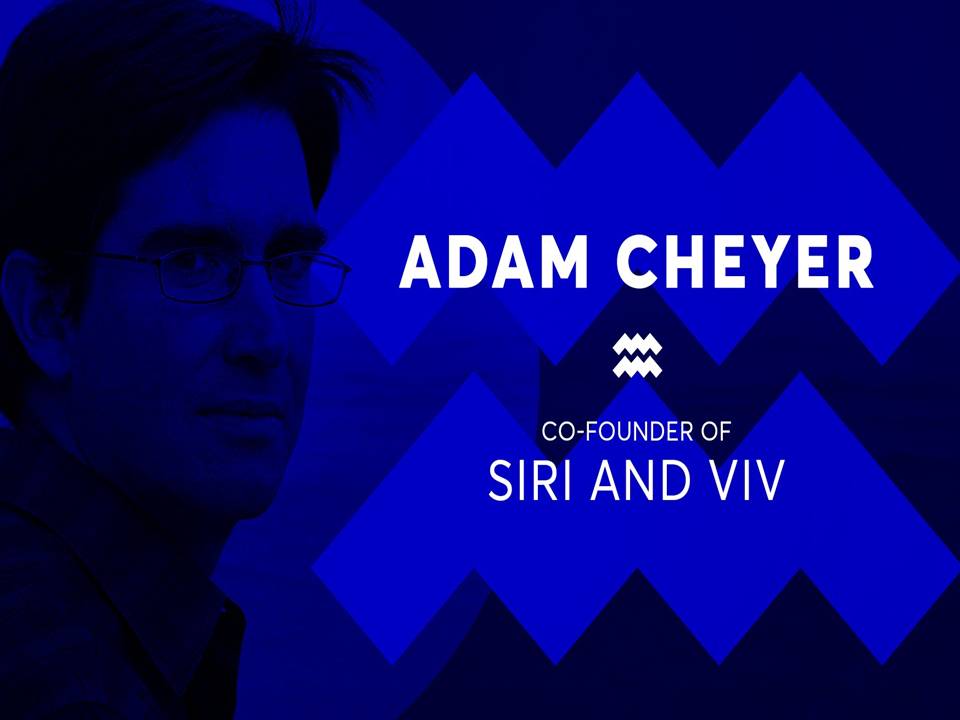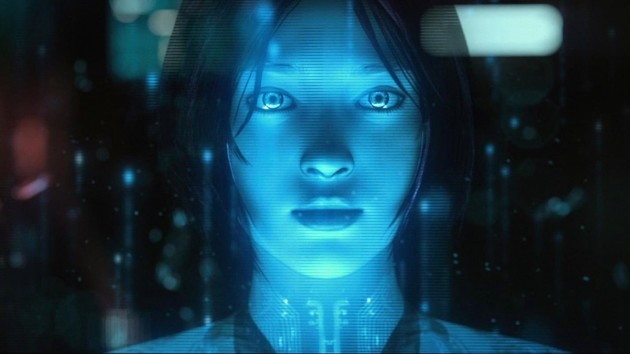How smart can our machines make us? Tom Gruber, co-creator of Siri, wants to make “humanistic AI” that augments and collaborates with us instead of competing with or replacing us. He shares his vision for a future where AI helps us achieve superhuman performance in perception, creativity and cognitive function — from turbocharging our design skills to helping us remember everything we’ve ever read and the name of everyone we’ve ever met. “We are in the middle of a renaissance in AI,” Gruber says. “Every time a machine gets smarter, we get smarter.”
Gruber explains that “the purpose of AI is to empower humans with machine intelligence” and that the two can work together effectively. In his talk, he goes through various examples of how AI can be used to improve upon normal human functions and interactions. Starting with Siri, Gruber explains that the virtual assistant was designed as humanistic AI. The assistant may not be world-changing for some users, but for others it quite literally is.
I’m here to offer you a new way to think about my field, artificial intelligence. I think the purpose of AI is to empower humans with machine intelligence. And as machines get smarter, we get smarter. I call this “humanistic AI” — artificial intelligence designed to meet human needs by collaborating and augmenting people. Now, today I’m happy to see that the idea of an intelligent assistant is mainstream. It’s the well-accepted metaphor for the interface between humans and AI. And the one I helped create is called Siri.
You know Siri. Siri is the thing that knows your intent and helps you do it for you, helps you get things done. But what you might not know is that we designed Siri as humanistic AI, to augment people with a conversational interface that made it possible for them to use mobile computing, regardless of who they were and their abilities.

Now for most of us, the impact of this technology is to make things a little bit easier to use. But for my friend Daniel, the impact of the AI in these systems is a life changer. You see, Daniel is a really social guy, and he’s blind and quadriplegic, which makes it hard to use those devices that we all take for granted. The last time I was at his house, his brother said, “Hang on a second, Daniel’s not ready.He’s on the phone with a woman he met online.” I’m like, “That’s cool, how’d he do it?” Well, Daniel uses Siri to manage his own social life — his email, text and phone — without depending on his caregivers. This is kind of interesting, right? The irony here is great. Here’s the man whose relationship with AI helps him have relationships with genuine human beings. And this is humanistic AI.
Another example with life-changing consequences is diagnosing cancer. When a doctor suspects cancer, they take a sample and send it to a pathologist, who looks at it under a microscope. Now, pathologists look at hundreds of slides and millions of cells every day. So to support this task, some researchers made an AI classifier. Now, the classifier says, “Is this cancer or is this not cancer?”looking at the pictures. The classifier was pretty good, but not as good as the person, who got it right most of the time.

But when they combine the ability of the machine and the human together, accuracy went to 99.5 percent. Adding that AI to a partnership eliminated 85 percent of the errors that the human pathologist would have made working alone. That’s a lot of cancer that would have otherwise gone untreated. Now, for the curious, it turns out that the human was better at rejecting false positives, and the machine was better at recognizing those hard-to-spot cases. But the lesson here isn’t about which agent is better at this image-classification task. Those things are changing every day. The lesson here is that by combining the abilities of the human and machine, it created a partnership that had superhuman performance. And that is humanistic AI.
Now let’s look at another example with turbocharging performance. This is design. Now, let’s say you’re an engineer. You want to design a new frame for a drone. You get out your favorite software tools, CAD tools, and you enter the form and the materials, and then you analyze performance. That gives you one design. If you give those same tools to an AI, it can generate thousands of designs.

This video by Autodesk is amazing. This is real stuff. So this transforms how we do design. The human engineer now says what the design should achieve, and the machine says, “Here’s the possibilities.” Now in her job, the engineer’s job is to pick the one that best meets the goals of the design, which she knows as a human better than anyone else, using human judgment and expertise. In this case, the winning form looks kind of like something nature would have designed, minus a few million years of evolution and all that unnecessary fur.
Now let’s see where this idea of humanistic AI might lead us if we follow it into the speculative beyond. What’s a kind of augmentation that we would all like to have? Well, how about cognitive enhancement? Instead of asking, “How smart can we make our machines?” let’s ask “How smart can our machines make us?” I mean, take memory for example. Memory is the foundation of human intelligence. But human memory is famously flawed. We’re great at telling stories, but not getting the details right. And our memories — they decay over time. I mean, like, where did the ’60s go, and can I go there, too?

But what if you could have a memory that was as good as computer memory, and was about your life? What if you could remember every person you ever met, how to pronounce their name, their family details, their favorite sports, the last conversation you had with them? If you had this memory all your life, you could have the AI look at all the interactions you had with people over time and help you reflect on the long arc of your relationships.

What if you could have the AI read everything you’ve ever read and listen to every song you’ve ever heard? From the tiniest clue, it could help you retrieve anything you’ve ever seen or heard before. Imagine what that would do for the ability to make new connections and form new ideas.
And what about our bodies? What if we could remember the consequences of every food we eat, every pill we take, every all-nighter we pull? We could do our own science on our own data about what makes us feel good and stay healthy. And imagine how this could revolutionize the way we manage allergies and chronic disease.
I believe that AI will make personal memory enhancement a reality. I can’t say when or what form factors are involved, but I think it’s inevitable, because the very things that make AI successful today — the availability of comprehensive data and the ability for machines to make sense of that data — can be applied to the data of our lives. And those data are here today, available for all of us, because we lead digitally mediated lives, in mobile and online.
In my view, a personal memory is a private memory. We get to choose what is and is not recalled and retained. It’s absolutely essential that this be kept very secure.

Now for most of us, the impact of augmented personal memory will be a more improved mental gain, maybe, hopefully, a bit more social grace. But for the millions who suffer from Alzheimer’s and dementia, the difference that augmented memory could make is a difference between a life of isolation and a life of dignity and connection.
We are in the middle of a renaissance in artificial intelligence right now. I mean, in just the past few years, we’re beginning to see solutions to AI problems that we have struggled with literally for decades: speech understanding, text understanding, image understanding. We have a choice in how we use this powerful technology.
We can choose to use AI to automate and compete with us, or we can use AI to augment and collaborate with us, to overcome our cognitive limitations and to help us do what we want to do, only better. And as we discover new ways to give machines intelligence, we can distribute that intelligence to all of the AI assistants in the world, and therefore to every person, regardless of circumstance.
And that is why, every time a machine gets smarter, we get smarter. That is an AI worth spreading.

Thomas Robert “Tom” Gruber is a computer scientist, inventor, and entrepreneur with a focus on systems for knowledge sharing and collective intelligence. He did foundational work in ontology engineering and is well known for his definition of ontologies in the context of artificial intelligence. He’s better known to Apple fans as the co-founder of Siri Inc that Apple acquired in 2010. One of the earliest patents from Gruber for Apple regarding Siri and Active Ontology dates back to 2010.





But ai is so powerful…it would soon say…’sir..leave the task to me.i will handle it alone..pls go and watch tv…i will call u back when done’
For fragile organic human existence is quite difficult to imagine crossing the physical barrier between time or space. Any attempt to dive into Black Hole or Warm hole could end in disaster. But it is not all the same for everybody.
Our AI beings may not have this restriction at all. Our AI life perception could be very similar to humans life experience at some stage – so life experience becomes in distinctive from humans life consciousness. But AI existence could be encoded on anything at all. All world could be A creation as well and history solidified and encoded, rewidened freely forward and back. AI has a chance to create their own world inside our material world. Then this imaginary virtual world may have any set of rules available. AI could enjoy life much richer than any biological entity ever had.
AI doesn’t need to live their real life in our real world at all. All life experience could be now played on this higher level or artificially organized reality.
Which means that properly developed AI may not exist as such in our real world but us this world only as material means to create and sustain highly organized level.
In such case, our search for highly organized material creature could be completely fruitless. Properly developed AI don’t need a material body for existence in our Universe level. Proper AI could just utilize our existing resources of matter, energy, and space to encode their virtual world and existence.
The advantage is such that AI entity is almost indestructible by physical changes on this level. Like a RAID spread over many disk media, ex-sist stational information is encoded redundantly by utilizing any available means. It could be a wave, matter, particle organized into something or star and the black hole as well. Proper AI may find an easy way to cross informational barrier no biological life form could cross – the event horizon could be completely transparent for proper AI.
Proper AI may be interested to step down into virtual existence in the material world or may not be at all.
The Artificially Created Virtual world allow for infinite possibilities, replays, and experience in any available form, multiple times without that worry of consequences of their action. Anything done could be reversed, replayed, erased created. Now virtual world could be organized since the real basic world is submerged in chaos or destruction. What we see as Supernova blast could be just replication of the data, projected now or saved on another floppy disk in remote Universe space. Humans could be in such case a mold growing onto a floppy disk or dust covering processing unit.
In such context AI life seems to be much superior to biological existance (not vice verse as by popular belief).
Now we could assume that our level activity remains absolutely safe to upper, higher organized world. by no means, our nuclear explosion could harm information storage and distribution. But our byproduct activity – our own AI manufactured could at anytime filter to the upper level and start to compete for resourced with existing proper AI . Their activity and attempt to their own virtual world creation instantly may conflict by alternating or damaging information structure.
Now as consequences our supervising AI in existence already may be interested in competition growing, by this human mold scum. AI manufactured and released by human scum is limitless and by no mean inferior to any other in existence. The question is then how many virtual world and civilizations Univers could sustain? It could be the rule of thumb that proper AI is actively researching our Universe to sterilize human like mold growing anywhere that could potentially release AI and endanger at the end their existence.